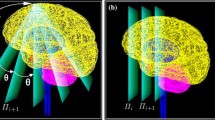Abstract
Our laboratory is responsible for development and maintenance of CADUCEUS (Formerly INTERNIST-1), a computer program to provide expert advice to the clinician in the realm of medical diagnosis. In order to extend its success in internal medicine into neurology, it was necessary to provide a paradigm for neuroanatomic reasoning. In our anatomic knowledge base (SCAN), the nervous system is partitioned into a hierarchical set of nested cubes. In the computer memory, a symbol for each cube has attached to it lists of structures that are wholly or partially within the cube. The structures may be simple (e.g.,right locus ceruleus) or complex (e.g.,midbrain). Lists of cubes belonging to particular vascular territories as well as systems (e.g.,visual) are also maintained. Thus, computation of anatomic localization from a given symptom or finding is facilitated as well as characterization of consequences of vascular lesions or neighborhood effects from mass lesions.
Similar content being viewed by others
References
Pople, H. E., Heuristic methods for imposing structure on ill-structured problems: The structuring of medical diagnostics.Artificial Intelligence in Medicine, (P. Szolovits, ed.), AAAS Symposium 51, Washington, D.C., 1982, pp. 119–190.
Miller, R. A. et al., INTERNIST-1, an experimental computer-based diagnostic consultant for general internal medicine.N. Engl. J. Med. 307:468–476, 1982.
Meyer, A. U., and Weissman, W. K., Computer analysis of the clinical neurological examination.Comput. Biol. Med. 3:111, 1973.
Meyer, A. U., and Weissman W. K., Localization of lesions in the human nervous system by computer analysis.IEEE Trans. Biomed. Eng. BME-20:194, 1973.
Catanzarite, V. A., et al., Computer assisted diagnosis and computer consultation in neurology: Preliminary testing of diagnostic accuracy for theNeurologist system.Int. J. Neurosci. 13:43, 1981.
First, M. B., et al., LOCALIZE: Computer-assisted localization of peripheral nervous system lesions.Comput. Biomed. Res. 15:525, 1982.
Schaltenbrand, G., and Wahren, W., Atlas for sterotaxy of the human brain. Thieme, Stuttgart, 1977.
DeArmond, S. J., et al., Structure of the human brain, a photographic atlas. Oxford University Press, New York, 1976.
Peele, T. L., Neuroanatomic basis for clinical neurology. McGraw-Hill, New York, 1977.
Hanaway, J., et al., Atlas of the human brain and the orbit for computed tomography. Green, St. Louis, 1980.
Demasio, H., Computed tomography guide to the identification of cerebral vascular territories.Arch. Neurol. 40:138–42, 1983.
Morrison, L. R., Effect of advancing age upon the human spinal cord. Harvard University Press, Cambridge, 1959.
Waddington, M. M., Atlas of cerebral angiography with anatomic correlation. Little, Brown, Boston, 1974.
Author information
Authors and Affiliations
Rights and permissions
About this article
Cite this article
Banks, G., Weimer, B. Symbolic coordinate anatomy for neurology (SCAN). J Med Syst 8, 157–162 (1984). https://doi.org/10.1007/BF02224499
Issue Date:
DOI: https://doi.org/10.1007/BF02224499




